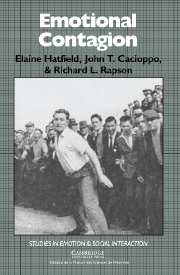Book contents
- Frontmatter
- Contents
- Acknowledgments
- Introduction and overview
- 1 Mechanisms of emotional contagion: I. Emotional mimicry/synchrony
- 2 Mechanisms of emotional contagion: II. Emotional experience and facial, vocal, and postural feedback
- 3 Evidence that emotional contagion exists
- 4 The ability to infect others with emotion
- 5 Susceptibility to emotional contagion
- 6 Current implications and suggestions for future research
- References
- Index
4 - The ability to infect others with emotion
Published online by Cambridge University Press: 05 June 2012
- Frontmatter
- Contents
- Acknowledgments
- Introduction and overview
- 1 Mechanisms of emotional contagion: I. Emotional mimicry/synchrony
- 2 Mechanisms of emotional contagion: II. Emotional experience and facial, vocal, and postural feedback
- 3 Evidence that emotional contagion exists
- 4 The ability to infect others with emotion
- 5 Susceptibility to emotional contagion
- 6 Current implications and suggestions for future research
- References
- Index
Summary
Introduction
If we pursue the analogy, thinking of the transmission of moods as akin to the transmission of social viruses, it seems reasonable to suppose that some people (the Typhoid Marys of this world) may well possess a natural ability to infect others with the “virus” while others (the Marcel Prousts) stand especially vulnerable to contagion. Norman Mailer (1979), in The Executioner's Song, interviewed Nicole Baker, the girlfriend of condemned killer Gary Gilmore. While Gilmore was on death row, Nicole had a brief affair with two men. Nicole loved Tom because he was able to infect her with his cheerful emotions. She loved Cliff Bonnors because he was in tune with her deepest feelings:
Cliff Bonnors was great because he always brought his mood around to meet hers. They could travel through the same sad thoughts never saying a word. Tom, she liked, for opposite reasons. Tom was always happy or full of sorrow, and his feelings were so strong he would take her out of her own mood. He wasn't dynamite but a bear full of grease. Always smelled full of hamburgers and french fries. He and Cliff were beautiful. She could like them and never have to worry about loving them one bit. In fact, she enjoyed it like a chocolate bar. Never thought of Gary when making love to them, almost never, (p. 329)
In this chapter, we consider the kinds of individual differences that affect men's and women's ability to shape an emotional climate.
- Type
- Chapter
- Information
- Emotional Contagion , pp. 128 - 146Publisher: Cambridge University PressPrint publication year: 1993



